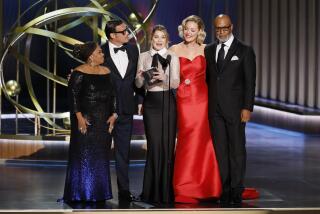Soaps go the way of the autos
- Share via
The Detroit carmakers are begging for billions in federal money and Susan Lucci has been forced to take a pay cut. Is no American institution sacred anymore?
Lucci, who has played Erica Kane on ABC’s “All My Children” since the series started in 1970, is just one of the soap stars swept up in a severe retrenchment seizing daytime TV. According to the trade paper Advertising Age, Lucci -- who at one time brought home a reported $1 million per year -- as well as costars Michael E. Knight and Ray MacDonnell have seen “substantial” paycheck reductions. So has Agnes Nixon, the soap doyenne who created “All My Children” and “One Life to Live” and now serves as a consultant to ABC Daytime.
Last month, to trim costs, NBC dumped longtime cast members Deidre Hall and Drake Hogestyn from “Days of Our Lives.” The network has reportedly chopped the licensing fee for its only remaining soap and is pushing to reduce actor salaries by as much as 40%. In a statement, ABC said it was “carefully and responsibly managing our costs.”
That both GM and the soaps find themselves hard-up is not coincidental. Ad Age pointed out that the auto manufacturers’ troubles have trickled down to local car dealers, who have long provided the principal source of ad support for soaps on local stations. “Local dealers and dealer associations accounted for nearly half of the $18.5 billion in 2007 measured media spending for automotive, according to TNS Media Intelligence data,” the trade paper reported.
But that trend is, of course, only part of the story. Soap operas, like Detroit, have been on a downward trajectory for years. The format originally grew out of radio serials -- “Guiding Light” started in 1937, at the tail end of the Depression -- and peaked in the mid-1970s, when viewers were suffering from a Watergate hangover and “Days of Our Lives” made the cover of Time magazine. The wedding of Luke and Laura on “General Hospital” was a genuine media sensation in November 1981, with an estimated 30 million viewers tuning in.
Those kinds of numbers are like a gauzy flashback for soaps today. CBS’ “The Bold and the Beautiful,” currently the most-watched network soap, has seen its audience shrink 17% over the past two seasons, to an average of 3.5 million total viewers this season, according to Nielsen Media Research. “All My Children” has shed 15% over the past couple years, to 2.5 million viewers. (NBC’s “Days” is the only soap to have shown any improvement, with 2.6 million viewers, up 5% compared with last season.)
The reasons for the decline aren’t hard to find. More women work outside the home than was the case 30 years ago, which crimps the soaps’ natural audience. The rise of daytime talk shows has made it tougher for soaps to compete; ABC’s “The View,” for example, is up 16% this season, to 4.1 million viewers. And networks’ daytime schedule feels the same pressure from cable TV competition that the prime-time lineups do.
As a result, few industry analysts expect the soap format -- one of TV’s oldest -- to enjoy a very bright future. Especially when, unlike their auto-industry benefactors, they don’t look like plausible candidates for a massive government handout.
--
More to Read
Inside the business of entertainment
The Wide Shot brings you news, analysis and insights on everything from streaming wars to production — and what it all means for the future.
You may occasionally receive promotional content from the Los Angeles Times.











